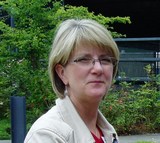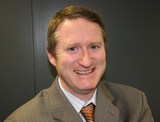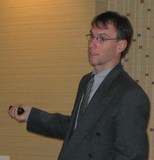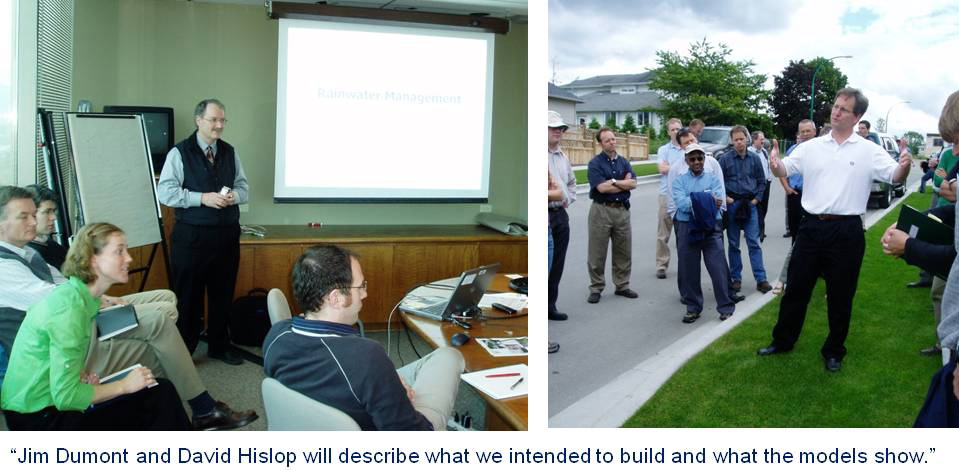SURREY FORUM STORY #3: Green Infrastructure in the City of Surrey: “Getting it built right”
Note to Reader:
To download a report-style, PDF version of the following web story, click on Green Infrastructure in the City of Surrey: “Getting it built right”.
Convening for Action in the Metro Vancouver Region
How do we simultaneously work together as staff within a municipality and as a region AND externally with developers and other private sector players, to ensure we implement sustainable approaches to development?
The foregoing challenge provided context for advancing a ‘regional team approach’ at the Metro Vancouver Water Balance Model Forum on March 12, 2009. Hosted by the City of Surrey, this learning event was co-sponsored by the Water Balance Model Inter-Governmental Partnership and the Green Infrastructure Partnership.
1. Regional Team Approach
 The Surrey Forum is a first step in advancing a regional team approach to rainwater management and green infrastructure that will align local actions in Metro Vancouver with provincial goals as stated in Living Water Smart, BC’s Water Plan. “We are adapting the experience gained and the lessons learned from the Vancouver Island pilot program,” states Raymond Fung, Chair of the Green Infrastructure Partnership.
The Surrey Forum is a first step in advancing a regional team approach to rainwater management and green infrastructure that will align local actions in Metro Vancouver with provincial goals as stated in Living Water Smart, BC’s Water Plan. “We are adapting the experience gained and the lessons learned from the Vancouver Island pilot program,” states Raymond Fung, Chair of the Green Infrastructure Partnership.
Vancouver Island Pilot Region:
At the 2008 Vancouver Island Learning Lunch Seminar Series hosted by the City of Courtenay, Margaret (Maggie) Henigman of the Ministry of Environment’s Nanaimo regional office provided this perspective during a town hall sharing  session: “Since 1996 I have been working across Vancouver Island, both reviewing development proposals and monitoring project implementation. In the last couple of years I have been really pleased to see a huge shift take place in the way projects are being done.”
session: “Since 1996 I have been working across Vancouver Island, both reviewing development proposals and monitoring project implementation. In the last couple of years I have been really pleased to see a huge shift take place in the way projects are being done.”
“As I reflect on the current Vancouver Island situation, it strikes me that we have created a new social norm; and it is being accepted by the development community as a whole. The change in attitude is really gaining momentum. Everywhere I go I am seeing evidence of the new ethic. It is not that everyone is perfect, but the change is really coming along.”
2. Why Surrey is a Leader
 “On the matter of implementing on-site rainfall capture, there is a fundamental difference between Surrey and other Metro Vancouver municipalities,” states Remi Dubé, Drainage Planning Manager with the City of Surrey. “Surrey has moved beyond pilot projects; we are moving to a broader watershed objectives approach to capturing rain where it falls to protect our streams.”
“On the matter of implementing on-site rainfall capture, there is a fundamental difference between Surrey and other Metro Vancouver municipalities,” states Remi Dubé, Drainage Planning Manager with the City of Surrey. “Surrey has moved beyond pilot projects; we are moving to a broader watershed objectives approach to capturing rain where it falls to protect our streams.”
Water Bucket Stories:
This is the third in a series of stories leading up to the Forum. Their purpose is to progressively connect the dots and establish expectations. Previously:
- Story #1 titled Living Water Smart and Making Green Choices to Create Liveable Communities and Protect Stream Healthintroduced what will be covered in the morning and afternoon sessions.
- Story #2 titled Making Green Choices: Opportunities for Law and Policy to Effect Change on the Ground introduced the shared responsibility theme, and is the bridge from the morning to the afternoon.
This Story #3 elaborates on the learning outcomes for the Forum morning session. Readers are encouraged to download copies of all three.
3. Forum Program – An Overview
The Forum program is built around the HOW question as it pertains to green infrastructure: HOW will the City of Surrey ensure it gets built right; HOW will a consistent regional approach be achieved in Metro Vancouver? The morning and afternoon parts of the program each comprise three modules.
“Everyone will benefit from attending both the morning and afternoon  sessions,” states Vincent Lalonde, the City’s General Manager, Engineering. “The policy people will have an appreciation for what is involved in constructing green infrastructure; and the implementers will understand what the provincial, regional and local goals are….and what we are trying to achieve in Surrey through the use of policy, approved standards and legal tools.”
sessions,” states Vincent Lalonde, the City’s General Manager, Engineering. “The policy people will have an appreciation for what is involved in constructing green infrastructure; and the implementers will understand what the provincial, regional and local goals are….and what we are trying to achieve in Surrey through the use of policy, approved standards and legal tools.”
4. Green Infrastructure in Surrey
The morning session will focus on the nuts-and-bolts of Surrey green infrastructure projects. “First, we will describe the evolution of drainage planning in Surrey (Module 1). We will also introduce the key neighbourhoods that embody the Surrey sustainability vision,” explains Remi Dubé.
“After that, we will reflect on the lessons learned on the ground in the East Clayton Sustainable Community (Module 2). Finally, we will share and reflect on the Grandview Heights and South Newton experiences (Module 3).”
Opportunities for Law and Policy to Effect Change on the Ground
“Module 3 will be conducted as a town hall sharing session about the design and construction aspects of green infrastructure implementation. This will set the stage for Module 5 in the afternoon when we will explore how policy and legal tools can help regulators, developers and designers collaborate to ensure responsible outcomes,” adds Vincent Lalonde.
 “What we’d like the town hall sharing session in Module 5 to draw out is that there are solutions to be found, if the different parties/ departments/ local governments and regions simply talk to each other about how they could all work together more effectively, using law reform or other process changes as tools,” states Susan Rutherford, who represents West Coast Environmental Law on the Green Infrastructure Partnership Steering Committee.
“What we’d like the town hall sharing session in Module 5 to draw out is that there are solutions to be found, if the different parties/ departments/ local governments and regions simply talk to each other about how they could all work together more effectively, using law reform or other process changes as tools,” states Susan Rutherford, who represents West Coast Environmental Law on the Green Infrastructure Partnership Steering Committee.
Building on a Decade of Experience
“Looking back, it is sometimes hard to believe that more than a decade has passed since the City initiated the East Clayton plan”, reflects Paul Ham, Past-Chair of the Green Infrastructure Partnership and retired General Manager, City of Surrey Engineering. “With the passage of time, we tend to take the early innovation for granted.”
 “Three provincial initiatives had an early influence on City of Surrey thinking. These were the UniverCity Sustainable Community on Burnaby Mountain, the Provincial Guidebook for stormwater planning, and the experience of the City of Chilliwack when it developed its Manual for Surface Water Management as a feedback loop for Guidebook development.”
“Three provincial initiatives had an early influence on City of Surrey thinking. These were the UniverCity Sustainable Community on Burnaby Mountain, the Provincial Guidebook for stormwater planning, and the experience of the City of Chilliwack when it developed its Manual for Surface Water Management as a feedback loop for Guidebook development.”
“The early results from East Clayton combined with the on-the-ground experience of Chilliwack gave Surrey the confidence to implement new Low Impact Development (LID) objectives in two plans – the Campbell Heights Economic Development Plan (1999-2000), and the Highway 99 Corridor Land Use Plan (2002). In fact, Council made the use of LID practices a condition of both plans”, explains Ham.
5. On-Site Rainwater Management Applied City-Wide
In 2008, Surrey Council endorsed By-Law No. 16610 (Surrey Stormwater Drainage Regulation and Charges). Part 5 is titled ON-SITE STORMWATER MANAGEMENT REQUIREMENTS. Clause 9 in Part 5 specifies that:
Newly created parcels shall be constructed with on-site stormwater management facilities when these are prescribed through Council approved neighbourhood plans, master drainage plans, integrated stormwater management plans or as required in a Servicing Agreement or specific service connection.
“On March 12, we will explain why and how this By-Law is the tool that enables the City to establish watershed-specific performance targets for rainwater runoff volume and rate reduction at the development site scale,” notes Remi Dubé. “Now we can determine what makes sense, meets multiple objectives, and results in net environmental benefits at a watershed scale.”
Performance Targets
Module 5 in the afternoon will introduce and provide a policy/legal context for Beyond the Guidebook: Establish Watershed-Specific Runoff Capture Performance Targets. This guidance document was released at the 2008 Water Balance Model Partners Forum.
“The law and policy module will close by focusing our discussion of roles, responsibilities and tools on how performance targets for a region might be both arrived at, and achieved,” foreshadows Susan Rutherford. “What are our respective roles and responsibilities for getting there? What tools can we use to ensure that we are aligned and effective in the work that we do?”
From Stormwater to RAINwater Management
On March 12, the discussion of performance targets will segue into Module 6: Making Green Choices: Use the Water Balance Model to Inform Land Development Strategies. This will be the subject of Story #4 in this series.
 “Choice of words is important; hence, changing the technical language is part of the process of advancing green infrastructure practices. We are weaning drainage practitioners away from a single-objective stormwater management way of thinking and designing…. to a way of doing business that is holistic, namely RAINwater management,” states Kim Stephens, Forum team leader and Program Coordinator for the Water Sustainability Action Plan for British Columbia,
“Choice of words is important; hence, changing the technical language is part of the process of advancing green infrastructure practices. We are weaning drainage practitioners away from a single-objective stormwater management way of thinking and designing…. to a way of doing business that is holistic, namely RAINwater management,” states Kim Stephens, Forum team leader and Program Coordinator for the Water Sustainability Action Plan for British Columbia,
“Increasingly, we have observed that the term RAINwater management resonates with non-engineers and the community at large. They intuitively get it. RAINwater management is about integration and an interdisciplinary approach that is landscape-based, and therefore goes well beyond the narrow engineering definition for conventional stormwater management.”
6. East Clayton Sustainable Community: Lessons Learned
According to Remi Dubé, “In Module 2, we have three objectives or learning outcomes in featuring East Clayton: provide the sustainability context; review the implementation experience for private and public rainfall capture systems; and reflect on lessons learned.”
The Neighbourhood Plan
The 250-hectare neighbourhood of East Clayton in Surrey was designated as ‘urban’ in 1996, setting the stage for an unprecedented new neighbourhood plan to increase residential density, promote social cohesion and maximize affordability and walkability.
Different housing zones were created, each with guidelines on lot configurations, including widths and setbacks, allowing developers to choose the housing mix. A ‘special residential’ category was included that allows small-scale businesses to be combined with residential units. Sixty per cent of the lots were to have rear lane access for cars, which allows property owners to build secondary units at the rear.
Good Intentions
 “A decade ago, the driver for innovation was the need to protect the downstream agricultural lowlands from flooding that would otherwise have resulted from the increase in annual rainwater runoff as the formerly rural East Clayton was converted to intensively urbanized residential development,” observes Remi Dubé.
“A decade ago, the driver for innovation was the need to protect the downstream agricultural lowlands from flooding that would otherwise have resulted from the increase in annual rainwater runoff as the formerly rural East Clayton was converted to intensively urbanized residential development,” observes Remi Dubé.
“To provide the complete picture, we are approaching the story of East Clayton in two parts. First, Jim Dumont and David Hislop will describe what we intended to build and what the models show. In part two, Monty Hurd, the City’s Manager of Engineering Inspections, will elaborate on what was actually built and where we ran into implementation challenges.”
Expectation
“We are anticipating that Monty’s part could be quite powerful in stimulating a sharing of experience. We hope that land development consultants in particular will tell their stories… because we will be getting into construction timing issues, in particular what happens to the topsoil and swales once the builders commence house construction, states Remi Dubé.
“The City and others certainly learned a lot from the East Clayton experience; and we have applied the lessons learned and adapted our approach in order to do business differently in Campbell Heights, Grandview Heights, South Newton, etc.”
“In addition to design and construction issues, the City also learned some lessons from a site development perspective. An unintended consequence was the higher than expected percentage of hardscape. With a different approach to built-form, we could have had both higher density and substantially more green space.” This is illustrated by the following comparison. On the left is what East Clayton looks like; on the right is what it might have been:
Water Balance Model Application
“East Clayton was one of the first test applications of the water balance methodology. The ‘new’ Water Balance Model incorporates the breakthrough in modelling approach that had its genesis in East Clayton,” notes Kim Stephens.” In the afternoon session on March 12, Jim Dumont will touch on this breakthrough when he elaborates on how the Water Balance Model can be applied to inform land development strategies.”
7. Effective Implementation of Green Infrastructure: Making it Work in Surrey
Half the morning session will be devoted to Module 3. “After the coffee break, we will be introducing a selection of innovative measures that are  being implemented City-wide for rainfall capture,” states Remi Dubé. “Then the Grandview Heights and South Newton case studies will provide the basis for a town hall discussion.”
being implemented City-wide for rainfall capture,” states Remi Dubé. “Then the Grandview Heights and South Newton case studies will provide the basis for a town hall discussion.”
“The town hall discussion will serve two objectives: first, establish the City’s expectations; and, secondly align efforts with the development community to meet the City’s expectations in doing business differently. We are looking forward to a lively exchange of perspectives by designers, developers and regulators.”
“Sam Lau, the City’s Manager of Land Development Services, will be the moderator for the town hall discussion. His group’s role is to be the bridge between the development community and the City’s engineering and planning departments. Having Sam’s group as a bridge helps us be clear regarding our objectives.”
Grandview Heights
“On March 12, we will be showcasing the Morgan Heights development because it exemplifies what we mean by shared responsibility. We have asked Ken Anderson, the development project manager, to tell his story at the Forum,” continues Remi Dubé.
Morgan Heights straddles about 79 hectares bounded by the Highway 99 corridor to the west, 28th Avenue to the north, 24th Avenue to the south, and 164th Street to the east. Morgan Heights is a planned community of 5400 people.
From Start to Finish:
“Ken provides a great perspective because his approach to development is to be involved from start to finish, really! He was part of the Neighbourhood Community Plan process; and he will be there when the last houses are built.”
“Ken truly has the big picture; this includes the City’s objectives, and the issues of community concern such as downstream drainage impacts. Ken is also intimately involved in the details, in particular ensuring that on-site rainfall capture systems are built properly.”
Making it Happen at the Site Scale:
“The key message about the Morgan Heights development is that Ken Anderson has taken responsibility to make rainfall capture happen on the lots that he has developed. He is holding securities for landscaping and sediment control; and that money is not released until after the houses are built.”
South Newton
“South Newton is a prime example of ask a different question, get a different answer,” reflects Remi Dubé. “In 2006, questions had been raised regarding the staging of construction and the components of the stormwater management  system as proposed in the Neighbourhood Concept Plan documents, which had been adopted in 1999 and updated in 2002.”
system as proposed in the Neighbourhood Concept Plan documents, which had been adopted in 1999 and updated in 2002.”
The South Newton study area is located within the Hyland Creek watershed – a tributary to the Serpentine River – in south Central Surrey. The study area encompasses the western portions of the South Newton NCP Area and is bounded by 64th and 58th Avenues on the north and south, respectively; and by 130th and 148th Streets on the west and east, respectively.
Infiltration Strategy:
“Jim Dumont found that by utilizing innovative infiltration systems, a number of detention ponds that had been identified in the original NCP could be eliminated. In this catchment, this could result in a multi-million dollar net reduction in the City’s 10-Year Capital Plan while enabling development to proceed.”
 “Through hydrologic and hydraulic analysis, we were able to demonstrate that distributed rainwater management infiltration systems will control runoff volumes, reduce potential stream erosion, and meet regulatory objectives,” reports Jim Dumont, Engineering Applications Authority for the Inter-Governmental Partnership.
“Through hydrologic and hydraulic analysis, we were able to demonstrate that distributed rainwater management infiltration systems will control runoff volumes, reduce potential stream erosion, and meet regulatory objectives,” reports Jim Dumont, Engineering Applications Authority for the Inter-Governmental Partnership.
“The infiltration system sizing and system operation was optimized to reduce the future potential stream erosion, to maintain the existing flow exceedance values, and to minimize the change in the magnitude of the flood discharges to the streams.”
Implementation:
“Whenever you try something different, there will be start-up challenges as developers, designers and regulators come to grips with the new way of doing  business. The way we look at it, every problem is an opportunity,” continues Remi Dubé.
business. The way we look at it, every problem is an opportunity,” continues Remi Dubé.
“The City has learned a lot from the early stages of on-site infiltration implementation in South Newton; and the experience gained has served as a valuable feedback loop that has enabled us to adapt our approach so that we in fact achieve the rainwater/stormwater management requirements.”
“Currently, building permits are not released until the on-lot infiltration systems are certified by a qualified professional engineer. This provides the City with considerable leverage to ensure compliance.”
“On March 12, the morning session will mainly focus on the technical aspects of infiltration implementation. In the afternoon, Susan Rutherford will expand on the legal and policy aspects of getting it built right. This will also provide representatives from other municipalities with a chance to share their experiences.”
“The key message for participants to take away from the Surrey Water Balance Model Forum is that the City is committed to moving forward with The New Business As Usual,” concludes Remi Dubé.
8. Advancing A Regional Team Approach
 “In holding the Surrey Forum, our vision is that this event will be the catalyst for additional regional forums that would be organized in collaboration with Metro Vancouver’s Stormwater Interagency Liaison Group…. i.e. SILG,” states Ted van der Gulik, Chair of the Inter-Governmental Partnership that developed and maintains the Water Balance Model.
“In holding the Surrey Forum, our vision is that this event will be the catalyst for additional regional forums that would be organized in collaboration with Metro Vancouver’s Stormwater Interagency Liaison Group…. i.e. SILG,” states Ted van der Gulik, Chair of the Inter-Governmental Partnership that developed and maintains the Water Balance Model.
An Historical Perspective
“British Columbia is recognized internationally as a leader in implementing a natural systems approach to rainwater management in the urban environment. In many ways, that recognition is an outcome of the trail-blazing efforts of SILG at the beginning of this decade. In fact, the Inter-Governmental Partnership itself began as a sub-group of SILG; then  quickly expanded to become a provincial group with municipal representation from four regions.”
quickly expanded to become a provincial group with municipal representation from four regions.”
“The efforts of SILG in championing research and innovation made it possible to develop the tools and promote the experience that helped overcome fear and doubt, and begin doing business differently. This enabled projects such as East Clayton to get off the ground.”
Showcasing Green Infrastructure Innovation
“We envision that the Surrey Forum will be a transformational event much as the 2005 REAC Consultation Workshop hosted by the City was a catalyst for action provincially. It resulted in the highly successful  Showcasing Green Infrastructure Innovation program on both sides of the Georgia Basin,” continues Raymond Fung, Chair of the Green Infrastructure Partnership which had its genesis in the SmartStorm Forum Series.
Showcasing Green Infrastructure Innovation program on both sides of the Georgia Basin,” continues Raymond Fung, Chair of the Green Infrastructure Partnership which had its genesis in the SmartStorm Forum Series.
“Because success leads to success, we would like very much to implement an educational program in Metro Vancouver that would be modelled on the Vancouver Island Learning Lunch Series.”
The Learning Lunch Model
 “Each series in the Vancouver Island pilot provided an inter-departmental learning opportunity for collaborative exploration. Each series comprised a set of three seminars. The series was conducted as a cumulative process, from philosophy to tools,” adds Kim Stephens. “A critical success factor was building the program around on-the-ground examples and walkabouts.”
“Each series in the Vancouver Island pilot provided an inter-departmental learning opportunity for collaborative exploration. Each series comprised a set of three seminars. The series was conducted as a cumulative process, from philosophy to tools,” adds Kim Stephens. “A critical success factor was building the program around on-the-ground examples and walkabouts.”
“By spreading the curriculum over three sessions, it enabled participants to take in new information, reflect on it, blend it with their own experience, test it, and eventually apply it in making decisions. In terms of the actual curriculum design, it was a matter of drawing upon a number of provincial guidance documents (notably Stormwater Planning: A Guidebook for British Columbia) and making them interesting and relevant to a mixed audience.”
Posted February 2009
















